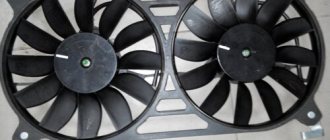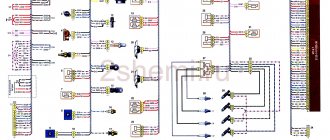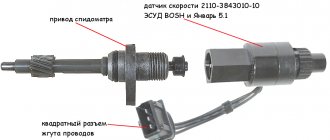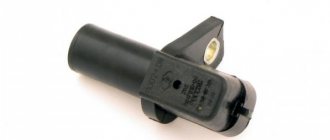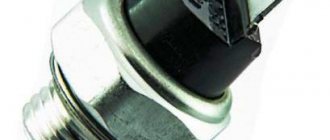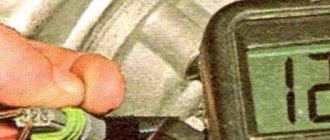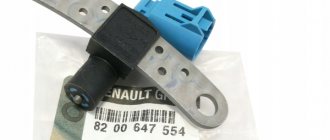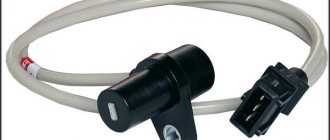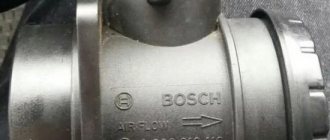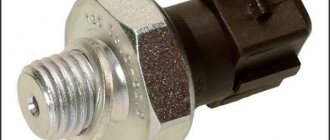The reason why the VAZ-2114 starts to stall at idle is the sensors, or rather their malfunction. Of course, the direct cause may be TPS, IAC or DMVR. But, as practice shows, usually the reason lies in the speed sensor. But, you should not immediately resort to replacement, since it is necessary to determine exactly the problem. To do this, it is worth conducting a diagnosis. This article will talk about the reasons for the failure of the speed sensor, as well as methods for diagnosing it.
Speedometer sensor location
Regardless of the year of manufacture of the car, this device is installed on the gearbox housing .
It is attached to the drive using a threaded connection. To find this sensor you need to look at the gearbox in the area of the right CV joint . Next, you should find a part with a connected electrical connector. Below is a photo of where the VAZ 2114 speedometer sensor is located. On older models, a cable is attached to the device. It is necessary to transmit torque to a mechanical speedometer.
Design and principle of operation
This sensor transmits information about the number of revolutions from the gears of the gearbox to the drive wheels of the car.
The same data goes to the car’s electronic control unit, and from it (if the sensor is completely electronic) to the car’s dashboard. For a description of the device and operation of the sensor, see below:
The fourteenth model uses 2 types of sensors:
- sensor with mechanical drive from the gearbox and electronic connection to the controller
- sensor with mechanical drive from the gearbox gear and cable drive of the speedometer
Signs of a faulty speedometer sensor
The car owner can independently determine the failure of the speed sensor. This does not require specialized education. In most cases, a malfunction is accompanied by the following symptoms:
- P0500 or P0503 on the electronic unit . In the first case, the error means loss of signal from the device. P0503 occurs when the signal supplied to the electronic control unit is unstable.
If errors occur, the cause of the breakdown may be not only the sensor, but also faulty electrical wiring. Often the transmission of incorrect data occurs as a result of oxidation of the contact pads of the connectors. In such a situation, to eliminate the malfunction, it is necessary to ring the wires and, if necessary, clean the connectors from oxidation.
- Incorrect operation of the internal combustion engine at idle. If a breakdown occurs, the speed of the power unit is unstable. Spontaneous engine stop at idle is possible. Additionally, the symptom may be accompanied by a significant increase in fuel consumption. This is due to the fact that the control unit receives incorrect data and cannot correctly select the fuel to air mass ratio.
- The speedometer or odometer does not work. The pointer needle may behave erratically or not move at all.
On cars with a cable-driven speedometer, incorrect operation of the indicator may not be associated with other symptoms. This means that the cable has broken. At the same time, the electronic part transmits correct data to the control unit.
- Decrease in engine power. The ECU cannot normally determine the speed of the vehicle and puts the engine into emergency mode.
The location of the speedometer sensor on the VAZ 2114 allows you to independently dismantle it and replace it with a new part without the use of specialized equipment.
Purpose
Let us immediately note that the task of this sensor includes several functions.
It is intended:
- To supply an electronic signal to the speedometer installed on the dashboard, resulting in the ability to control the speed of movement and the distance traveled;
- Based on the readings of this sensor, the electronic unit adjusts and sets optimal speed in different modes of movement;
- The sensor signals influence the operation of the idle speed sensor.
How to check the speed sensor?
You can check the functionality of the device that determines the speed using a multimeter or a test lamp. Diagnostic measures are carried out in the following order:
- Locate the part.
- Disconnect the electrical connector.
- Set the multimeter switch to DC voltage measurement mode.
- Connect one probe of the device to the contact of the signal wire. For more reliable fixation, you can use a specialized clamp.
- Attach the second probe of the multimeter to the car body. The electrical equipment of the VAZ 2114 is made according to the single-wire principle. The car body is the negative contact.
- Jack up the front wheel. Before doing this, it is necessary to eliminate the risk of spontaneous rolling of the car. To do this, install anti-roll devices under the wheels.
- Turn on the ignition.
- Rotate the wheel with different intensity as the car moves. When accelerating, the voltage should increase, and when decelerating, it should drop accordingly.
You can check the device by removing it from the car. To do this, you should forcibly rotate its moving part and take measurements in the same way. If you don’t have a multimeter, you can use a 12V car lamp.
If during the diagnostic process it was revealed that the sensor is working, you should look for a fault in the wiring. In some cases, the pointer indicator fails.
Design and principle of operation
Three generations of speed sensors were installed on injection engines of the tenth VAZ family.
- Electromechanical with a cable stretched to the speedometer. The torque was transmitted through a gear drive from the gearbox. The most capricious option in operation and unreliable in indications.
- Electromechanical without cable. The rotation transmission was still gear-based, the electrical signal was transmitted through wires.
Both of these sensors transmitted output shaft speed using complex mechanics that often failed.
Let's look at this design in more detail.
The Hall effect is that when a concentrated electric field passes through a magnetic field, an electrical impulse occurs. To “materialize” it, a semiconductor is placed in a magnetic field, at the ends of which a completely measurable voltage appears. This impulse is the same signal that is sent to the electronic speedometer and engine control unit. The speed sensor connection diagram clearly demonstrates the principle of operation of the speed sensor on a VAZ 2114 car.
As you can see, the signal goes not only to the speedometer unit.
In accordance with the operating principle of the Hall system, one revolution of the sensor shaft generates one electrical pulse. At the same time, there are no unnecessary mechanics: only the input shaft of the device connected to the output shaft of the manual transmission.
How impulses are converted into speed and mileage
There is a known quantity: the circumference of a car tire. Of course, this system works correctly only when installing standard tires and normal tire pressure. The ECU and sensor controller take readings and convert them into mileage. That is, the odometer has already received its share of information. Divide this value by time - we get the speed of movement.
Replacing DS with VAZ 2114
The part can be replaced at home. The work can be performed by a person who does not have specialized knowledge and experience. Replacement is carried out in the following sequence:
- Turn off the on-board power supply voltage. To do this, remove the negative terminal from the battery.
- Remove the corrugation. This is necessary for unhindered access to the sensor.
- Disconnect the electrical connector. The plug is equipped with two latches that prevent spontaneous disconnection.
- Unscrew the device counterclockwise.
Installation of the new part must be carried out in reverse order. In some cases, the sensor drive may need to be replaced at the same time as the sensor.
Functionality check
If you are wondering how to check the speed sensor, then diagnostics can be carried out in several ways.
- Place the gearshift lever in fifth gear and jack up the front wheel.
- You should disconnect the plug from the controller; to do this, you just need to squeeze the latches and disconnect the chip.
- Using a wire, connect the DC to the battery and voltmeter.
- Spin the wheel. If the DC is working, then you can see how the pulse signals change - from 0.5 to 10 V.
What speed sensor is installed on the VAZ 2114?
Depending on the year of manufacture of the car, two types of sensor can be installed on the VAZ 2114. One with electronic communication with controller and speedometer. The second one has a mechanical connection to the speedometer and an electronic connection to the controller.
The market offers a wide selection of speed sensors for the VAZ 2114 from various manufacturers. The average cost is 350-450 rubles .
On VAZ 2114 cars, the speed sensor is used not only to transmit data to the speedometer, but also to communicate with the electronic control unit. The part can be replaced at home without the use of specialized tools.
The test showed a negative result - the unit will have to be changed
To remove and install, you will need one tool: a 22mm wrench. The nut should be unscrewed with caution: the thread may become stuck due to unfavorable operating conditions. The VAZ 2114 speed sensor is replaced after cleaning the “seat” on the gearbox housing. Be sure to check the condition of the wire insulation and the integrity of the connector. Buy a branded sensor from a trusted supplier.
Before connecting the connector, it is necessary to lubricate the contacts with electrical compound. This will protect the contacts from corrosion for a long time. Be sure to secure the signal cable so that it does not fray due to vibration.
Design
The speed sensor is made of plastic, inside of which there is an electrical circuit that converts mechanical energy into electrical impulses transmitted to the ECU.
The sensor has an internal thread, thanks to which it is installed on the speedometer drive. The DSA transmits impulses through wires, so it has a special connector that connects to the car's wiring, and then to the ECU.
Inside the sensor there is a special plastic shaft, which is installed in the speedometer drive and then rotates the electrical part inside the sensor. Quite often, this shaft is cut off, which leads to damage to the sensor, after which the sensor cannot be repaired, but only replaced with a new one.
Instructions for removing and replacing the sensor
So, to get to the DS, you need to remove either the adsorber or the air filter housing. It is better to go one way and remove the adsorber, which is secured with 2 bolts.
Disconnect the positive terminal from the battery and unscrew the two nuts securing the adsorber, then lift it up and move it to the side.
The speed sensor will be located at the top of the gearbox next to the dipstick. Disconnect the terminal from the sensor and unscrew it by hand. If you tighten it too much, you will need a 21 wrench.
Having unscrewed the old sensor, we carry out all the necessary diagnostics described below, and reassemble in the reverse order.
How to fix the problem
Once it has been possible to determine the malfunction of the speed sensor, further actions depend on the reasons that caused this situation. The following solutions are possible:
- Dismantling the sensor and checking it using a multimeter using the above method. If the sensor is faulty, it is most often replaced with a new one, since it is quite difficult to repair it. Some “traditional craftsmen” try to solder flying chip elements manually using a soldering iron. However, this does not always work out, so it is up to the car owner to decide whether to do this or not.
- Check sensor contacts. One of the most popular reasons why the speed sensor does not work is contamination and/or oxidation of its contacts. In this case, it is necessary to inspect them, clean them, and also lubricate them with special lubricants in order to prevent the occurrence of corrosion in the future.
- Check the integrity of the sensor circuit. Simply put, “ring” the corresponding wires using a multimeter. There can be two problems - a short circuit and a complete break in the wires. In the first case, this is caused by damage to the insulation. A short circuit can occur either between individual pairs of wires or between one wire and ground. You need to go through all the options in pairs. If the wire breaks, there will be no contact at all. If there is slight damage to the insulation, it is permissible to use heat-resistant insulating tape to repair the damage. However, it is still better to replace the damaged wire (or the entire harness), since the wires often operate at high temperatures, so there is a high risk of repeated damage. If the wire breaks completely, then, naturally, it needs to be replaced with a new one (or the entire harness).
Sensor repair
Some auto repairmen with electronics repair skills are engaged in restoring the speed sensor on their own. In particular, in the case described above, when under the influence of high temperature the capacitor is soldered off and it begins to short-circuit and pass current.
This procedure consists of disassembling the speed sensor housing to check the functionality of the capacitor and, if necessary, replacing it. As a rule, microcircuits contain Japanese or Chinese capacitors, which can easily be replaced with domestic ones. The main thing is to choose the appropriate parameters - the location of the contacts, as well as its capacity. If the sensor housing is dismountable, everything is simple, you just need to remove the cover in order to get to the capacitor. If the case is non-separable, you need to carefully cut it without damaging the internal components. In addition to the requirements listed above for choosing a capacitor, you also need to pay attention to its size, since after soldering to the board, the sensor housing should be closed again without any problems. You can glue the case using heat-resistant glue.
According to reviews from craftsmen who have performed a similar operation, you can save several thousand rubles in this way, since a new sensor is quite expensive.
Conclusion
A breakdown of the speed sensor is a non-critical, but quite unpleasant problem. After all, not only the speedometer and odometer readings depend on its normal operation, but also fuel consumption increases, and the engine does not operate at full power. In addition, individual vehicle systems are forcibly switched off, which can, among other things, affect traffic safety, both in city mode and on the highway. Therefore, when identifying problems with the speed sensor, it is advisable not to delay fixing them.
Source

